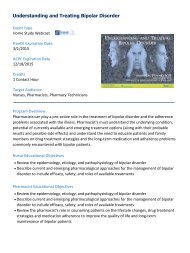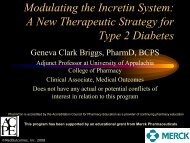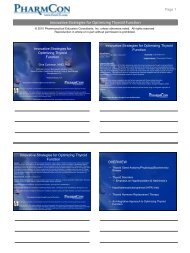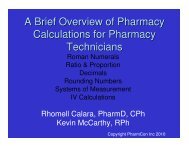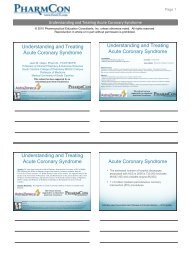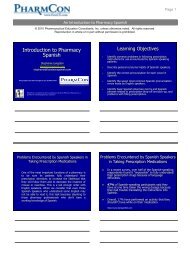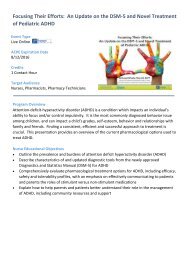Insulin Pens and Improving Patient Adherence - Free CE Continuing ...
Insulin Pens and Improving Patient Adherence - Free CE Continuing ...
Insulin Pens and Improving Patient Adherence - Free CE Continuing ...
Create successful ePaper yourself
Turn your PDF publications into a flip-book with our unique Google optimized e-Paper software.
<strong>Insulin</strong> <strong>Pens</strong> &<br />
<strong>Improving</strong> <strong>Patient</strong><br />
<strong>Adherence</strong><br />
Bonnie Pepon, RN, BSN, CDE<br />
Certified Diabetes Educator<br />
Conemaugh Diabetes Institute<br />
Kip Benko, MD FA<strong>CE</strong>P<br />
Asst Clinical Professor<br />
University of Pittsburgh School<br />
of Medicine
Diabetes<br />
• 21 million people in the U.S. have<br />
diabetes<br />
• $132 billion each year<br />
• Type 1 diabetes: no insulin production<br />
• Type 2 diabetes: some insulin production
Goals of <strong>Insulin</strong> Therapy<br />
• To keep the blood glucose levels as close to<br />
normal as possible<br />
• Fasting 70-100 mg/dl<br />
• After meals 100-140 mg/dl<br />
• To prevent acute <strong>and</strong> long term complications<br />
• To keep the HbA1c at 6.5% - 7%<br />
• To feel better if you are in your goal range
Type 1 Diabetes
<strong>Insulin</strong> Production of Type 2
The Era of <strong>Insulin</strong> Delivery<br />
• Began in August of 1921<br />
• Canadian Surgeon<br />
Frederick Banting &<br />
assistant Charles Best
<strong>Insulin</strong> Delivery Systems<br />
Available Now
<strong>Insulin</strong> Devices<br />
Syringes<br />
• Syringes are most widely available<br />
• Can be adjusted to 1 or ½ units<br />
• Can use most types of insulin<br />
• Require good vision to measure a dose
<strong>Insulin</strong> Devices<br />
<strong>Pens</strong><br />
• Portable injection choice<br />
• Easy to set the correct dose by a dial<br />
• Can be adjusted with ½ units or 1 unit<br />
• Can use most types of insulin<br />
• Very convenient <strong>and</strong> accurate for the vision<br />
impaired <strong>and</strong> those on the go
<strong>Insulin</strong> Devices<br />
Pumps<br />
• Results in better diabetes control<br />
• More flexible eating schedule<br />
• Dose adjusted by 1/10 to 1/20 units<br />
• Requires higher level of involvement &<br />
more advanced diabetes education <strong>and</strong><br />
skills
Syringe/Needle/Vial<br />
• Most common method of delivery<br />
• Syringes (range of sizes)<br />
• needle gauge<br />
• needle length<br />
• syringe capacity<br />
• 3/10cc, 1/2cc, 1cc
Syringe/Needle/Vial<br />
• <strong>Insulin</strong> comes in U–100 in the U.S.<br />
• orange cover <strong>and</strong> black scale<br />
• 100 units of insulin per milliliter of<br />
fluid in the vial<br />
• U–500 available<br />
• high insulin resistance using more<br />
than 200 units a day<br />
• Outside the U.S.: U-40<br />
• red cover <strong>and</strong> red scale
<strong>Insulin</strong> Syringes<br />
• Multiple manufacturers<br />
• BD, Monoject, SureComfort,<br />
Ulticare Precision Sure Dose,<br />
UltiGuard, Medicore, Aimsco<br />
• Injection aides<br />
• Inject-Ease by BD <strong>and</strong> Palco,<br />
Instaject (can be combined<br />
with a lancet device),<br />
NeedleAid, NovoPen 3<br />
Penmate
<strong>Insulin</strong> Needles<br />
• Syringes available<br />
• 1/2 in or 12.7 mm<br />
• 5/16 or 8mm<br />
• Pen needles available<br />
• ½ in<br />
• 5/16 in<br />
• 3/16 in<br />
• Gauges available<br />
• 31, 30, 29, 28
<strong>Insulin</strong> Injection Sites
<strong>Insulin</strong> Types<br />
• Almost all the insulin sold in the U.S.<br />
is “human insulin”<br />
• DNA recombinant technology<br />
• 4 types of insulin available<br />
• Previously: insulin from beef <strong>and</strong> pork<br />
sources
Rapid Acting <strong>Insulin</strong><br />
<strong>Insulin</strong><br />
Onset of<br />
action<br />
Peaks<br />
Duration<br />
Humalog<br />
or lispro<br />
Novolog<br />
or aspart<br />
5 to 15<br />
minutes<br />
30 to 60<br />
minutes<br />
3 to 5<br />
hours<br />
Apidra<br />
or glulisine<br />
Short Acting <strong>Insulin</strong><br />
Humulin R<br />
or Novolin<br />
R<br />
30<br />
minutes<br />
2 to 3<br />
hours<br />
3 to 6<br />
hours<br />
•Clear in appearance<br />
•Available in vials <strong>and</strong> pens
Intermediate Acting <strong>Insulin</strong><br />
<strong>Insulin</strong><br />
Onset of<br />
action<br />
Peaks<br />
Duration<br />
Humalin N<br />
(NPH) or<br />
Novolin N<br />
(NPH)<br />
2 to 4<br />
hours<br />
4 to 12<br />
hours<br />
12 to 18<br />
hours<br />
•Cloudy in appearance<br />
•Available in vials <strong>and</strong> pens<br />
Long Acting <strong>Insulin</strong><br />
Levimir<br />
(detemir)<br />
1 to 2<br />
hours<br />
6 to 8<br />
hours<br />
6 to 23<br />
hours<br />
Lantus<br />
(glargine)<br />
1 hour<br />
no peak<br />
24 hours<br />
•Clear in appearance<br />
•Available in vials <strong>and</strong> pens<br />
•Cannot be mixed in the same syringe with any other type of insulin
<strong>Insulin</strong><br />
Humalog<br />
mix 75/25<br />
or 50/50<br />
Humulin mix<br />
70/30 or<br />
50/50<br />
Novolog mix<br />
70/30<br />
Novolin mix<br />
70/30<br />
Pre-mixed <strong>Insulin</strong><br />
Onset of<br />
action<br />
30<br />
minutes<br />
Peaks<br />
2 to 4<br />
hours<br />
Duration<br />
22 to 24<br />
hours<br />
•Helpful for those with poor eyesight, dexterity problems or<br />
those who have trouble mixing from 2 different vials
<strong>Insulin</strong> <strong>Pens</strong><br />
• Pre-filled disposable pen or refillable pens<br />
with cartridges<br />
• Uses an insulin needle<br />
• available in different sizes <strong>and</strong> gauges<br />
• units can be counted as dialed by a click<br />
• plunger is pushed in <strong>and</strong> held for several seconds<br />
before removing the needle
<strong>Insulin</strong> <strong>Pens</strong><br />
• Storage in refrigerator until the pen is<br />
started<br />
• storage life ranges from 7 to 42 days<br />
• Pre-filled pens<br />
• 28 days: Humalog/Novolog/Novolin R<br />
• 14 days: Novolin N<br />
• 10 days: Novalin 70/30
Humalog<br />
Novolin R<br />
<strong>Insulin</strong><br />
Novolin 70/30 <strong>and</strong><br />
Novolin N<br />
<strong>Insulin</strong> <strong>Pens</strong>:<br />
<strong>Insulin</strong> Cartridges<br />
1.5 ml<br />
28 days<br />
30 days<br />
7 days<br />
3 ml<br />
Days<br />
Novolin<br />
R/Novolog/Lantus<br />
Novolin N<br />
Novolin 70/30<br />
Levemir<br />
28 days<br />
14 days<br />
10 days<br />
42 days
<strong>Insulin</strong> <strong>Pens</strong>
<strong>Insulin</strong> Pumps
<strong>Insulin</strong> Pumps<br />
• Delivers a rapid acting insulin<br />
through a flexible tube inserted<br />
under the skin<br />
• Users get a continuous flow of<br />
basal insulin<br />
• Also delivers a bolus dose to<br />
cover meals or elevated blood<br />
glucose levels<br />
• Worn 24 hours a day/7 days a<br />
week
<strong>Insulin</strong> Pumps<br />
Advantages<br />
• Waterproof<br />
• Include a carb wizard or<br />
carb counter<br />
• Mimic the way a healthy<br />
pancreas works<br />
• Allows greater flexibility in<br />
insulin delivery<br />
• Provides better glucose<br />
control<br />
Disadvantages<br />
• Increased risk of moderate<br />
to severe low blood sugars<br />
• Risk of inflammation <strong>and</strong><br />
infection at the insertion site<br />
• Increased risk of high blood<br />
sugars <strong>and</strong> ketoacidosis<br />
• Must do an increased<br />
amount of blood glucose<br />
readings<br />
• Cost is around $6,000
Inhaled <strong>Insulin</strong><br />
• Delivers rapid acting dry powder insulin<br />
• Absorbed through the lungs into the bloodstream<br />
• 1mg <strong>and</strong> 3mg blister packets<br />
• Cannot be used for smokers, children, pregnant women<br />
or anyone with lung problems<br />
Will be taken off the market in January 2008
Jet Injector<br />
• Force tiny stream of insulin<br />
through the skin<br />
• Doesn’t puncture the skin<br />
• Pressure can cause bruising<br />
• Sometimes more painful<br />
• Cleaning can take a long<br />
time<br />
• Expensive <strong>and</strong> may not be<br />
covered by health insurance
<strong>Insulin</strong> Infuser<br />
• Minimize needle sticks by creating a portal to<br />
inject insulin into<br />
• A small tube is inserted into the fatty tissue of<br />
the injection site<br />
• It is taped in place for 2-3 days<br />
• <strong>Insulin</strong> injected into the tube via pen or<br />
syringe instead of the skin<br />
• Drawbacks: risk of infection <strong>and</strong> complaints of<br />
discomfort
<strong>Insulin</strong> Delivery Systems<br />
In the Future<br />
• Oral insulin<br />
• Transdermal insulin<br />
• Buccal insulin<br />
• Artificial pancreas<br />
• Implantable insulin pump
Oral <strong>Insulin</strong><br />
• <strong>Insulin</strong> is a protein that would be<br />
broken down during digestion before it<br />
can work<br />
• Needs a protective coating to protect it<br />
from digestion<br />
• None have been successful as of yet
Transdermal <strong>Insulin</strong><br />
• <strong>Insulin</strong> is a larger molecule than nicotine<br />
• SpectRx, Inc.,has in development a<br />
“pumpless patch”<br />
• Possible systems may be combined with<br />
ultrasound <strong>and</strong> electric current
Buccal <strong>Insulin</strong><br />
• Spray absorbed by the lining at the<br />
back of the mouth <strong>and</strong> cheeks<br />
• Some think it will be better absorbed<br />
than inhaled since it doesn’t go into the<br />
lungs
Implantable <strong>Insulin</strong> Pumps<br />
• Causes less hypoglycemia than external<br />
pumps<br />
• Requires a surgical<br />
procedure to<br />
frequently unclog
Artificial Pancreas<br />
• Different approaches include:<br />
• gene therapy, bioengineering or medical<br />
equipment approach<br />
• New area of FDA regulations
Artificial Pancreas<br />
• Surgically implanted closed loop system<br />
• Automatically adjusts insulin doses as<br />
needed<br />
• Users release bolus insulin via remote<br />
control
Cost Saving Alternative<br />
• Type 2 Diabetes patients<br />
• 1,162 patients using syringe/vial<br />
• 168 who began with a pre-filled insulin pen<br />
• Total annual health care costs per patient<br />
excluding prescriptions<br />
• pen group: $14,900 per patient<br />
• syringe group: $32,000 per patient
Cost Saving Alternative<br />
• 1,100 patients already using a syringe<br />
• half were switched to a pen during the<br />
course of study<br />
• Results showed annual healthcare costs<br />
were only slightly higher<br />
• $11,476 per patient vs. $10,755 per patient
Case Study<br />
John has started to draw up his<br />
insulin pen to the dose he needs<br />
<strong>and</strong> his cell phone rings. John<br />
stops to answer his phone.<br />
When he is done he has<br />
forgotten how many units he has<br />
drawn up. What should John do?



